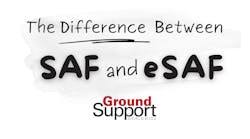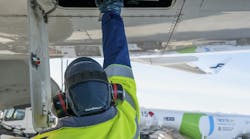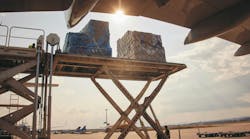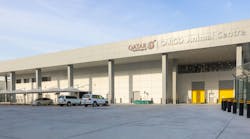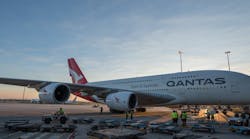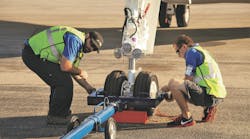On April 10, 2024, Johnson Matthey and BP announced that DG Fuels has chosen their co-developed Fischer-Tropsch (FT) CANS technology for its first sustainable aviation fuel (SAF) plant in Louisiana. This marks a strategic achievement for Johnson Matthey's Catalyst Technologies and represents the 10th large-scale sustainable technology win since April 2022.
Krista Johnson, U.S. country president for Johnson Matthey, answers a few questions on the technology behind the largest non-HEFA SAF production facility in the world, with a planned capacity of 600,000 metric tons (MT) of SAF per year – capable, after blending to 50 percent, of producing enough SAF for more than 30,000 transatlantic flights annually.
Q: What is the need for sustainable aviation fuel (SAF)?
A: The need for sustainable aviation fuel arises from the industry's increasing recognition of its environmental impact, particularly its contribution to reduce greenhouse gas emissions and mitigate climate change. Sustainable aviation fuel offers a drop-in alternative to traditional fossil fuels, reducing carbon emissions and promoting environmental sustainability. Additionally, it helps fuel providers meet regulatory requirements and addresses airlines’ growing consumer demand for eco-friendly travel options.
According to the International Energy Agency, in 2022, aviation accounted for approximately 2 percent of global energy-related CO2 emissions, a faster growth in recent decades than rail, road, or shipping. As international travel demand recovers following the COVID-19 pandemic, aviation emissions in 2022 reached almost 800 MT CO2, about 80 percent of the pre-pandemic level.
Q: How is SAF currently produced?
A: Driven by the lower capital costs and the availability of feedstocks, which are close in energy density to fossil fuels, most of the SAF supplied today is derived using the hydroprocessed esters and fatty acids (HEFA) pathway. The process involves refining vegetable oils, animal fats (tallow) or used cooking oil into a mixture of hydrocarbons that can be blended with traditional jet fuel. Currently, SAF accounts for less than 0.1 percent of global aviation fuel. There is simply not enough SAF to meet demand, and it is clear the world needs to scale-up production to meet announced targets.
Q: What is the Fisher-Tropsch reaction, and why is it essential to the future of sustainable aviation?
A: The Fischer-Tropsch (FT) reaction refers to the conversion of synthesis gas—a blend of carbon monoxide, carbon dioxide and hydrogen — into hydrocarbons in the presence of a catalyst.
The FT reaction is a recognized method for producing aviation fuel as it enables SAF production from eco-friendly sources, such as gasified municipal solid waste, waste biomass or captured carbon dioxide and low-carbon hydrogen. Its versatility is a significant advantage over HEFA with its ability to leverage both advanced bio-based feedstocks and the power-to-liquids pathway, vastly expanding its available feedstocks.
Q: What is Johnson Matthey's FT CANS technology, and how was it developed?
A: Johnson Matthey and BP have been collaborating on the development of FT technology since the 1990s. This resulted in a gas-to-liquids demonstration plant being constructed and operated in the early 2000s. The goals of the plant were to demonstrate the first generation of fixed-bed FT technology, prove the first-generation catalyst lifetime, provide operational experience, and validate kinetic and thermodynamic models.
After the demonstration plant completed all its objectives, the team wanted to build on this experience and develop a new generation of FT technology. As a result of improvements to the catalyst and a radical change to process engineering, the FT CANS Technology was conceived and launched in the 2010s.
Q: How does FT CANS work?
A: The patented reactor design uses catalyst carriers or CANS inserts that allow the use of larger tubes compared to traditional fixed-bed reactors and significantly reduce the tube count while maintaining the required heat removal. In the process, gas sequentially flows through the CANS carriers, entering down a central channel, with the reaction taking place radially outwards.
The gas and liquid products are then cooled by transferring heat to boiling water on the shell side. A seal prevents the gas from bypassing the next carrier, and the gas enters the carrier below to repeat the process. Around 60-80 CANS carriers are loaded in each tube, effectively creating mini-adiabatic reactors in series with inter-bed cooling.
Q: What is the importance of radial flow?
A: The reactor concept allows radial flow through each CANS carrier in a large diameter tube, which means the sum of the catalyst bed thickness is less than 15 percent of the overall tube length. The benefit of radial flow is that it enables the use of much smaller catalyst particles with low-pressure drop and much higher space velocities. This results in excellent heat and mass transfer to and from the catalyst particles, enabling a step-change in performance.
Q: What are the overall benefits of FT CANS technology?
A: Catalyst volumes can be reduced by over 50 percent, and the technology delivers a 95 percent reduction in tube numbers compared to conventional tubular reactors. The FT CANS technology provides a three-fold increase in production for the same size reactor and enables greater than 90 percent overall CO conversion in a single-stage recycle loop that can operate with more than 50 percent inerts.
Another big advantage of JM/BP’s technology is the catalyst is supplied prefilled in the carriers, ready to load into the reactor for activation and start up. Once removed from the reactor, the catalyst can be sent for metal recovery in the CANS carrier, so the catalyst never has to be handled. All these advantages contribute to significant capex reduction in the FT CANS unit of over 50 percent compared to conventional fixed-bed technology.
Unique Aspects of the DG Fuels Project
The DG Fuels project in St. James Parish, Louisiana, USA, is the largest announced SAF plant using FT technology and the largest non-HEFA-based SAF facility in the world. The plant is designed to produce SAF as its only product, with a planned capacity of 13,000 barrels/day. Historically, the FT pathway was known for producing a range of products, including naphtha, kerosene and diesel. The DG Fuels plant demonstrates the versatility of the FT CANS technology in allowing customers to select the best products and scale for their markets.
The versatility and flexibility of FT CANS, both in terms of scale and product selection, is crucial. Some customers may choose sustainable naphtha, which can be produced because the process is flexible. In this instance, the customer wanted SAF at scale, which we delivered.

